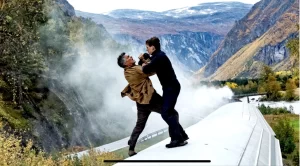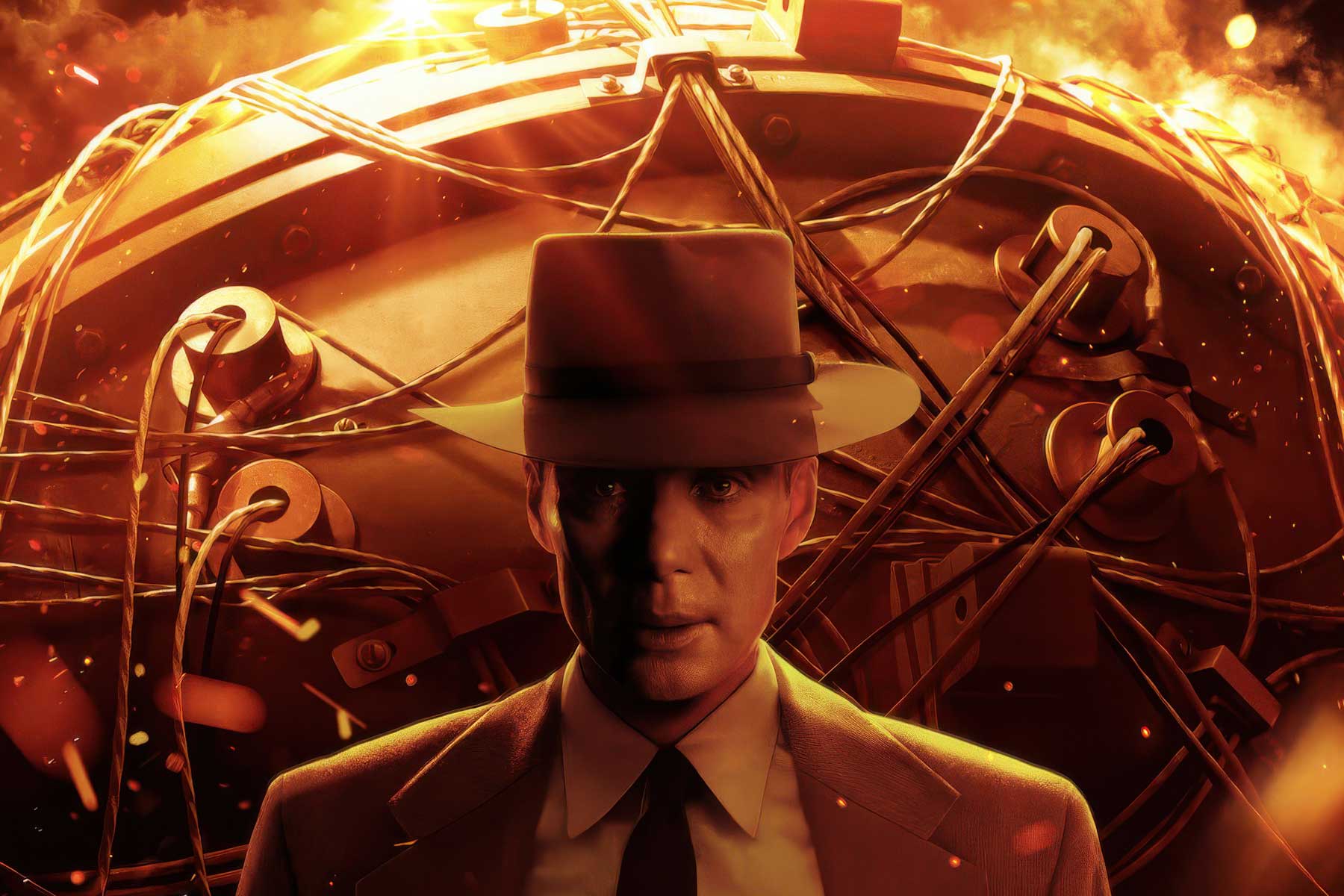I have checked out not just one Mission Impossible, but two, the latest Mission Impossible: Dead Reckoning Part One with Tom Cruise returning as agent Ethan Hunt in the 7th installment in the series, and Oppenheimer, with Cillian Murphy in Christopher Nolan’s large-screen epic about the race to beat Germany to the atomic bomb in WWII. Tune in here to listen to the review or read on.
The film universe is atwitter – you should pardon the expression–with Barbieheimer, the race between two mass market films, Barbie and Oppenheimer, that are both opening this weekend to chase big numbers at the box office like the old days, pre-everything. At least as interesting is the performance test between Mission Impossible: Dead Reckoning and Oppenheimer. Greta Gerwig’s Barbie and Christopher Nolan’s Oppenheimer are in their way similar and what the industry needs—fresh auteurist visions where one is light satire with a feminist intent, and the other a dark mea culpa on the use and abuse of male power. But Mission Impossible: Dead Reckoning represents the continued uninspired retooling of past franchises – Bond, Bat, Super and Spiderman, Marvels that are no longer marvels — that are the default position of risk-averse corporate filmmaking. This is the cancer that was eating away at theatrical attendance 30 years before the pandemic landed theaters in the ICU.
Writer-director Christopher McQuarrie’s Dead Reckoning with Tom Cruise hopping from planes to trains and at least one clown car, and Oppenheimer with the lesser-known Cillian Murphy as J. Robert Oppenheimer, the man who birthed the atom bomb and regretted it even before the fallout rained down, however, are both about missions impossible—to save the planet for good or ill. Oppenheimer, however, is the bet made by visionary filmmaking associated with the great American indie explosion of the early 70s in Marty Scorsese and especially Francis Ford Coppola that the way forward is by investigating the American character, in fiction or in history, to take the pulse of the culture in which we now live.
Dead Reckoning did well in its first week out. And given that everyone in the industry, specially during these strike months, is watching the vital signs of both theatres and distributors, that’s a cheering sign if you care about the biz.

But the health of the art — meaningful, fresh character narrative that has Tolstoy’s aspirations to paint the broader moment and David Lean’s imperative to make it big – lies with Christopher Nolan’s Oppenheimer, lensed by his cameraman on Tenet, Dunkirk and Interstellar, Hoyte Van Hoytema. It’s spirit may lie with American indie filmmaking, but Oppenheimer was made using the elite and expensive cutting edge tech tools of film, crafted by people at the top of their art, with limitless resources backed by a studio, Universal, releasing it in standard film, digital IMAX, and in its best iteration that matches how it was shot on a 70-millimeter IMAX film camera – shown at a premium price of $26.99 at Loews 68th Street in NYC, one of 19 theaters in the US and 30 worldwide equipped to show it.
Nolan’s 12th film – you may remember his Memento back in 2000 about what we need to remember — has two principal concerns on its mind: 1) the moral no-man’s land entered by Oppy, the scientist given a sports team nickname when he led the Manhattan Project in Los Alamos to build the atomic bombs dropped on Japan to end the war, and 2) the ensuing security driven fascism of the Communist witch hunt in Congress less than a decade later that destroyed Oppenheimer’s reputation and his career. At three hours and distilled from the 2006 Pulitzer Prize winning 700 -page book, American Prometheus, The Triumph and Tragedy of J. Robert Oppenheimer by former Nation columnist Kai Bird and Martin J. Sherwin, the film’s arc follows Oppenheimer from his days as a university student who was a lab klutz but a good theoretical physics thinker, through his selection to bring the bomb to bear on the war effort, and the multiple layers of tragedy that ensue.
There are the overlapping politics of university life, military protocols, the war, the post war madness, and the personal dynamics, from marriage to professional egos, that must be threaded and orchestrated on a metronome keyed at first to the German head start on developing a bomb, led by Werner Heisenberg, he of the already famous Heisenberg principle that if you can see it, you’ve altered its nature. Then the metronome of The Red Scare takes over, and we watch Murphy’s 60-foot face trying to reconcile his heartsickness with the inexorable political buzzsaw of petit tyrants coming at him that Sean Connery’s James Bond or Tom Cruise’s Ethan Hunt routinely escape.
The film is peopled by front rank actors at the top of their power – Murphy as Oppy, Emily Blunt as his wife Kitty, Matt Damon, Robert Downey Jr. in a standout turn as Oppy’s Brutus, Tony Goldwyn, Kenneth Branagh (as Niels Bohr), David Krumholtz, Bennie Safdie (Edward Teller), Josh Hartnett, Rami Malek, Casey Affleck, Florence Pugh and Gary Oldman as a chameleon Harry Truman. Nolan returns to the screen 80s British leading man Tom Conti as Albert Einstein and Josh Peck, lost since Nickelodeon’s 2004 series, Drake & Josh, as the nervous wreck here who pushes the button at Los Alamos.
Nolan’s film positions Oppenheimer to understand the necessity of the project, even as the swirl historically pondered how, especially where and whether to use it. Oppenheimer in Nolan is divided against himself. Even on a screen as large as a football field, there’s a lot of one-on-one ruminations before and after the countdown to the Trinity test blast, which Nolan creates in a fireball, and the ultimate bombing of Hiroshima and Nagasaki delivered more demurely here over a radio report and newsreel aftermath. Oppenheimer is ultimately ruined as a Communist security risk by Senate investigations shown here that drop out to IMAX in black and white. But how we see him hinges on one line, when he responds to a colleague’s private suggestion that the bomb is so terrible they really ought to keep the Soviets in the loop. The film stops for a beat. “That would be treason,” Oppenheimer says here, and he’s having none of that. Ergo, chalk up Oppy as another wronged patriot and a man so traumatized by doubt he’s incapable of defending himself in the face of the fascist McCarthy period.
Everything in America always does come down to how Walt Kelly summarized it in Pogo long ago: “We have met the enemy, and they is us.” This Oppenheimer is brave, ambitious, magnificently accomplished in its filmmaking and on point.
This 7th in the series of Mission Impossibles, Dead Reckoning, begins in a super stealth Russian sub that yields a lot of dead Russians bobbing up beneath the Arctic ice cap and a two-part, interlocking brass key vital to defeat the enemy and save the planet. The hunt is on! Through two hours and 43 minutes, I never did figure out who the enemy is that Cruise as the returning rogue agent Ethan Hunt is battling. He’s got it going on two fronts: his own CIA on the one hand and on the other what?, who? huh?
It helps if the times you live in afford an enemy that corresponds to the real world, but here it’s abstracted into a metaphor called The Entity. (How’s that for a screenwriter hedge?) After all the high tech stuff the CIA uses and Cruise abuses in this film, I never did get how the fate of the planet hinges on finding a brass key? I kept thinking that key sure looks like the one my parents used to open a Chinese dry bar (with pearl inlays) that my father bought for our living room in 1958 at the LS Ayres Dept store in Indianapolis and which my brother transferred from my pile to his pile when we closed up the house in Toledo. “Ethan, don’t kill yourself, my brother has a key like that on Fullerton Ave in Chicago,” I wanted to shout.
No worries, as Cruise, Hayley Atwell as hot female agent Grace, Ving Rhames as the sidekick and Simon Pegg as the techie, engage in a millisecond by millisecond never-ending pitched battle with The Entity, transversing the globe to do chop-socky stunts on the roof of a speeding train, a slap-stick shift tear through Rome in a circus yellow Fiat 500, and leaps of faith over rooftops in Venice and the Swiss Alps and across the sands of Abu Dhabi in a mission that plays out as really quite possible after all to save the world. Yes, Tom Cruise is a Unicorn, as my son calls him. And as with all franchise victories, Carvel Cone afterwards.


